Pacha Mama I'm Coming Home
"Pacha Mama I’m coming home
Pacha Mama, I’m coming home
To the place where I belong
Pacha Mama, I’m coming home,
To the place where I belong!
I want to be free, be me, Be the being that I see
Not to rise and not to fall, Being one and loving all
There’s no high, There’s no low
There is no place I should go
Just inside a little star
Telling me, be as you are.
Just inside a little star telling me – be as you are"
- Deirdre Cavener

Itinerary; Quito - Galapagos Island - Guayaquil - Cuenca - Baños - Quito
Quito
After an elongated travel of 24 hours, with 2 nights spent in buses as we crossed the border from Colombia to Ecuador {For border crossing, refer to the blog on Colombia}, we spent time in Quito relaxing & rejuvenating. Started the day off with yoga [available at Community Hostel at 8:00 AM & 5:00 PM on weekdays] followed by a long session of reflexology & an evening walking around Centro Historico.
Located on a hilltop, the old city is a labyrinth. Apparently the city has been built on the ashes of the Inca empire, since the Inca general Rumiñahui burnt it to the ground instead of surrendering to the Spanish conquistadors.

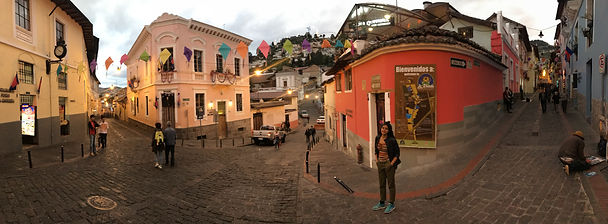
Centro Historico has myriad plazas and as you walk towards the hills, one enters the funnest part of town aka Calle La Ronda that has several restaurants, bars & live music, muchas fiesta! A famosa restaurante is Leña Quiteña, known for its guinea pig. It has a beautiful view of the city but cocktails here are merely average. We tried an Empanada Pasty, with cheese stuffing that was delicious, reminded us of the 'Bhatura' that we get in Delhi, India.

Some adventures unfolded mystically. I left a pair of glasses in an airbnb where we stayed at Cuenca, and thus, had to coordinate with folks who had stayed at the place after us and came to Quito thereafter. Our meeting with them resulted us in visiting a mirador, Palestina, from where we could see the entire city. At a restaurant called Pim’s, we overlooked Quito as we sipped on Pim’s (the named called for it) & ate fantastic food! My glasses sure helped us pick the perfect place to spend the afternoon.
Mitad Del Mundo [Middle of the World]
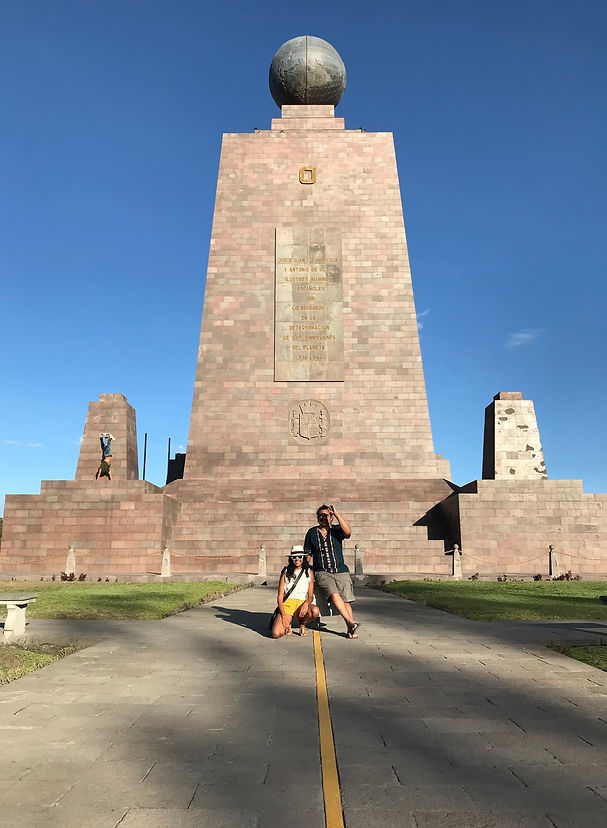




$1300 per person
13
days
12/24/18-01/06/19
Getting There
Taxi from Ecuadorian Border to Tulcan Bus Terminal
-
Duration: 10 minutes
-
Cost: $3
Bus from Tulcan to Quito [Carcelen Bus Terminal]
-
Duration: 6 hours
-
Cost: $6
Flight from Quito to San Cristobal, Galapagos Island
-
Duration: 1 hour 45 minutes
-
Airline: Avianca
-
Cost: $350
Bus from Guayaquil to Cuenca
-
Duration: 4 hours
-
Cost: $8
Bus from Cuenca to Baños
-
Duration: 6 hours to Riobamba + 1.5 hours to Baños
-
Cost: $8 + $2
Bus from Baños to Quito
-
Duration: 4 hours
-
Cost: $3
Stay
Quito
-
Airbnb: $30 per night
-
Location: Close to Quito's commercial zone
-
Rating: 4 out of 5
San Cristobal, Galapagos Island
-
Hostel Gosén: $60 per night for a private room
-
Location: Central
-
Rating: 4 out of 5
Cuenca
-
Airbnb: $30 per night for a private room in a bed & breakfast
-
Location: Central
-
Rating: 3 out of 5
-
Comments: Internet is very slow
Baños de Agua Santa
-
Airbnb: $40 per night
-
Location: Central
-
Rating: 4 out of 5
Food Much & Alcool
Quito
-
Miskay: Typical Ecuadorian, Fish fillet with mashed plantain - YUM!
-
Pims Restaurant at Palestina Quito's Mirador point
-
La Ronda [Several restaurants including Leña Quiteña]
-
Honey Oats & Coffee: For the best desserts in Ecuador!
San Cristobal, Galapagos Island
-
Las Playa: Local seafood
-
Midori [Sushi Bar]: For the best pisco sours in town
Cuenca
-
Ture, Mirador point for cocktails
-
Calle Larga: Goza Restaurant for cocktails & brunch
Baños
-
Trout
-
Llapingacho
-
Churrasco
-
Seco De Chivo
Local Travel
Disclaimer: Ubers in Colombia & Ecuador are DOUBLE the price of local taxis, so best to hail local cabs & give directions based on GPS. They are still illegal in both countries which is probably why they are so much more expensive, something that one doesn’t figure out immediately as a visiting tourist.
Day Trips around Quito
Mitad Del Mundo {Equator}
-
Duration: 1.5 hours by bus
-
Cost: 0.40 cents + $5 [Collectivos available to return at a cost of $5]
Volcano Cotopaxi & Lake Quilotoa
-
Duration: 2.5 hours & 3 hours respectively
-
Group tours: $45 [Must be booked 10 days in advance]
-
Private car: $150
Baños
-
Casa del Arbol [15 minutes away]: Taxis charge $10 for one way or $20 to wait for an hour & return
-
Pailon Del Diablo [15 minutes away in a different direction than casa del arbol]: Taxis charge $10 for one way or $20 to wait for an hour & return
Highlights
Quito
-
Centro Historico
-
Palestina
-
La Ronda
-
Mitad Del Mundo [Middle of the World]
-
Day trips / overnight stay at Cotopaxi Volcano / Quilotoa Lake
San Cristobal, Galapagos Island
-
Kicker Rock
-
Wildlife: Sea lions, Tortoise, Sea Turtles, Great Frigate Birds, Blue-Footed Booby Birds, Hammerhead Sharks, Galapagos Sharks, Sting Rays
-
Snorkeling & Scuba Diving
-
Isla Lobos
Cuenca
-
Centro Historico
-
Ture
-
Baños de Cuenca
Baños
-
Casa Del Arbol
-
Pailon Del Diablo
There's a direct bus from Palestina to Mitad Del Mundo, which translates to middle of the world. The bus took us 1.5 hours, cost 0.40 cents per person and is always a great way to get a feel of the local vibe, with people selling different things en route, some subtly grooving to music playing in the bus, being able to practice Spanish while asking for directions and getting an overview of the city. Quito is sprawling and over the decades has grown to expand well beyond the central part of town, very similar to Mexico City.
The middle of the world is where the equator lies at 000 latitude and the yellow line signifies the equator that moves constantly within a radius of 5 kilometers due to the Earth’s changing physical forces of rotation. The yellow line crosses the monument at approximately zero degrees zero minutes & zero seconds and can be verified by the GPS [our phone had no internet so couldn’t try it out but sure, would be fun]. Out here sunrises and sunsets are the earliest, and on March 21st as well September 21st, the sun is perpendicular to the earth, resulting in no shadow during mid-day!

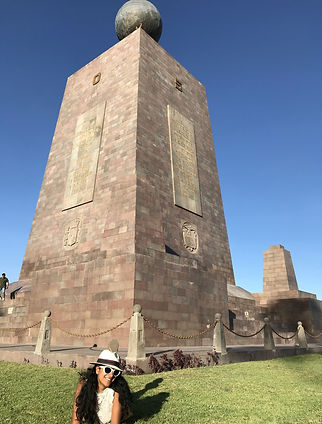
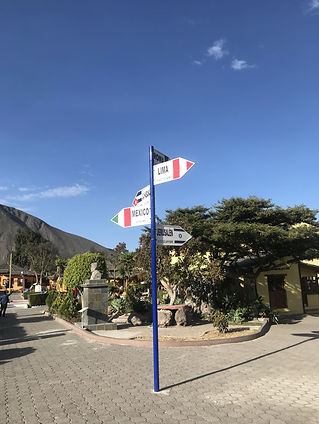
The monument that was built in 1970 to mark the middle of the world, was apparently a result of the geodesic mission that was undertaken by Ecuador, Spanish & French to measure meridian quadrants and affirm that the earth was round! Seems quite late to prove that assertion considering Pythagorus proposed that the Earth was round as early as 500 B.C :)
All in all, it is surreal enough to be in the middle of the world & walking on the equator! For the return journey, there is an option of jumping into a shared van that runs every hour, 7:00 PM being the last one for $5 per person.

Cotopaxi Volcano

Overnight camping at Volcano Cotopaxi & Lake Quilotoa is a great way to experience both places holistically. With the volcano 2.5 hours away & the lake 3 hours away from Quito, visiting both the places in a day can be a rushed experience and we would recommend visiting Cotopaxi for a day hike and then spending the night at Quilotoa.
Cotopaxi is an active volcano, located in the Andes at a height of 5897 meters. With the altitude being high, it’s makes for an extremely intense climb. To reach the summit, hikers are encouraged to train in advance. One can however trek the volcano for an hour to reach Refugio, the base where the actual hike begins.
We decided to hike Rumiñawi, a dormant volcano across from Cotopaxi to get a beautiful view of the active volcano. Located at 4721 meters above sea level, it was still a difficult climb given the high altitude. One needs time to acclimatize, otherwise dizziness, light-headedness and breathless may be experienced. We didn’t complete the trek but used the opportunity to engage with our enthrallment of nature’s treasure that stood upfront.

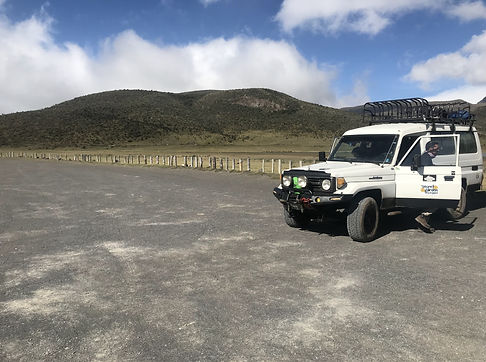

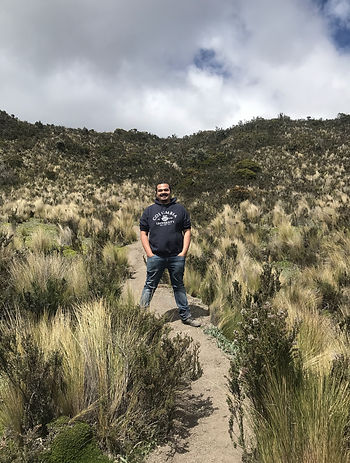


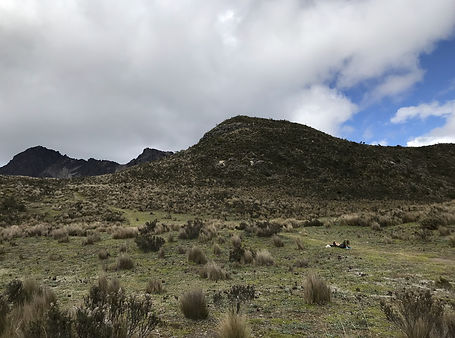


Getting there:
Hiring a car and driving on one’s own is an option.
Given limited time and the fact that we booked last minute, group tours were already full. Otherwise, group tours are available to explore both places in a day for $45. I’m unsure how much time one spends at each site, but it’s worth exploring given the economical rate.
Through a tour company, we hired a car with a driver, which cost us $150. It was on the steep side, but we were certain we didn’t want to miss visiting these glorious places and did have complete flexibility with regards to the time we spent at both sites.
Entrance to the Cotopaxi National Park:
If you're not from Ecuador, the advice is to befriend someone local at the entrance because the office makes tourists pay an additional $35 for a guide, which is really not necessary. Folks from Ecuador are allowed to enter & climb the volcanoes in the vicinity on their own. We met some great Ecuadorians who graciously spoke to the officials on our behalf and we were able to take our car inside and climb some part of the dormant Rumiñawi with our new amigos.
Lake Quilotoa

This gorgeous gem lies 2 hours away from Quito. A crater on the top of a volcano, a visit to Laguna Quilotoa is an epic experience. One can trek down to the lake, which takes around 3 hours and canoe / kayak into the turquoise green hues. The best way to experience it is to camp here for the night, so that one wakes up to the colors, wilderness & calmness that water brings. Having done a hike earlier in the day, we decided to enjoy the laguna from atop as we embraced the landscapes, mischievous clouds & the indescribable beauty of the laguna.
Kirutwa Musuk Wasi; One of the only restaurants from where you can view the laguna. Trout is the most widely available food, not the most delicious, but worth sipping a few beers and enjoying the glorious view.
Galápagos Islands
Planning for the best adventure


-
Plan to get to the airport well in time, since a separate check is required for one’s luggage in addition to buying a tourist card ($20) per person.
-
At the time of entering, one is required to pay $100 for conservation of the islands.
-
Make sure you’re carrying enough cash to the islands, we withdrew from the ATM at Quito Airport for a minuscule charge of .50 cents.
-
ATM's are easily available though at San Cristobal Island, but charge a higher fee.
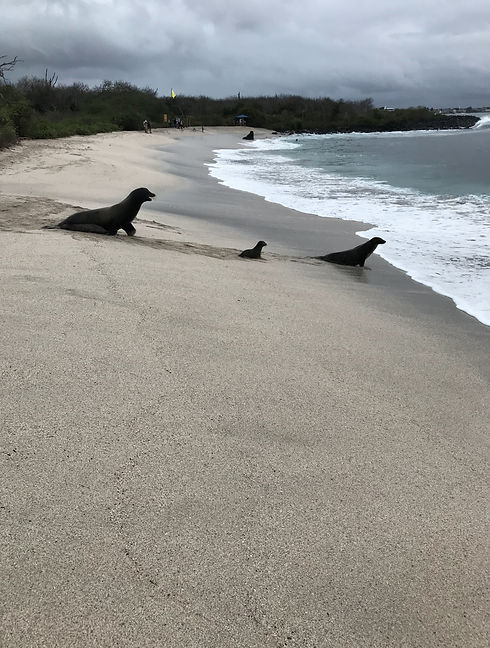

The islands emerged more than five million years ago & since then the process of formation has been ongoing. The continual eruption of the volcanoes resulted in the creation of these archipelagos & currently the islands are the top of massive submarine mountains. Around two million years ago, similar to Easter Islands in Chile, a few seeds blown by the wind arrived at Galapagos, resulting in germination & eventually vegetation & life in the islands.
We flew into San Cristóbal, the capital of the Galapagos province. The islands itself are excruciating expensive and it’s worth planning out how one intends to optimize the experience.
Being an archipelago, Galapagos has several islands & we had to choose whether to spend our time in San Cristóbal or travel to the other islands of Santa Cruz, Española, Isabella amongst others. Santa Cruz is super touristic, it’s the only other island connected via flight & can be used as a base for exploring neighboring islands as well.
It’s recommended to spend at least 4 days in every island & so we decided to spend the time we had in San Cristóbal.
San Cristobal Island
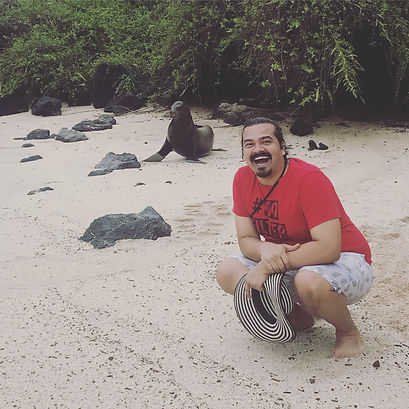
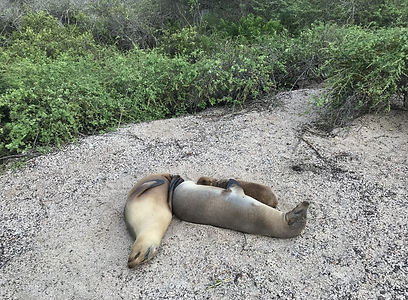
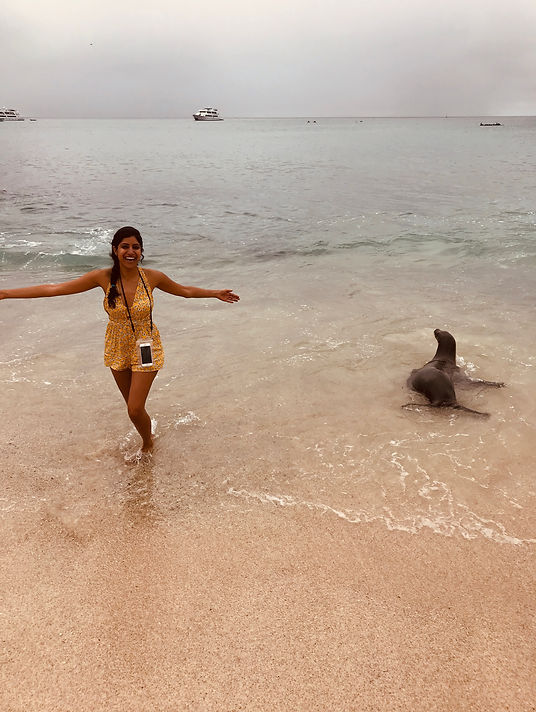
The island has a few beaches within walking distance. Barely a kilometer away from the main part of town, Playa Mann is supremely busy. Regardless of the crowd however, what you will find in profusion are sea lions, simply adorable! Basking in the sun, sleeping away to glory or swimming relentlessly, sea lions are unperturbed by the human presence. Galápagos has succeeded at building a culture where all animals are treated with respect, and there is no attempt whatsoever to scare, pet, or feed the animals, because of which there is a beautiful co-existence. Apparently in 1982, the islands where sea lions originally resided was hit by the niño, a weather current that emerges every couple of years, which is when the sea lions arrived at Galápagos. Spread out through the archipelago, sea lions are everywhere. They aren’t harmful, though sometimes the male sea lions may get territorial so best to maintain some distance.
One of the highlights was snorkeling with sea lions, they are immensely playful & are excited by the bubbles, sometimes coming super close to one’s mask, which initially may be intimidating but it’s the most amazing feeling as you relax into the connection! Underwater you see them having a ball, flipping from one end to the other, blowing out their own bubbles & surfacing only to breathe. They make loud sounds to communicate with each other and if it’s a family or friends together, you hear responses right back. It was most fascinating to observe sea lion families. I could stare at them for hours seeing their patterns. Sea lions we identified as males because of their larger structure, oftentimes, continued to follow the females, whose head structure seemed thinner. At one instance, one baby had gotten separated, and we saw the female swim through the water followed by the male to collect the kiddo, the re-union was heartwarming! Another instance, we witnessed a female who got deeply upset by a tourist who had come too close & it led her to grab her kiddo hard with her mouth, literally flinging him/her towards her away from this disrespectful tourist.
For Playa Coruna, one walks ahead through a trail to reach a stunning expanse of water touching the sky with rocks in the background providing a base to a lighthouse, several iguanas, crabs & of course, sea lions. As you continue the exploration you can walk up the hill & get a panoramic view of the ocean.
The town of San Cristobal is small & there are a few bars & restaurants, close to the pier with terrace seating & fantastic views. We ended up frequenting Midori, a sushi bar, which was unusual to find in this far off island in the middle of nowhere. We didn’t try the sushi, but they surely made the best pisco sours that I’ve had after Peru. Make sure they give it in their mega steal mugs with environmentally-friendly steal straws!
Our host recommended Restaurant Las Playa, a few meters ahead of our hostel, and it had great fried shrimp. Run by two local ladies, make sure you’re there well in advance of your meal because it is extremely slow island style service, but the wait was worth it!
Galapagos is basically designed around tours and it’s impossible to get to any island without signing up for these tours. The boat taxis at the pier only take one for a spin around the bay. We did a few tours to experience the best of San Cristóbal.
1. Galapaguera, El Junco, Playa Puerto Chino



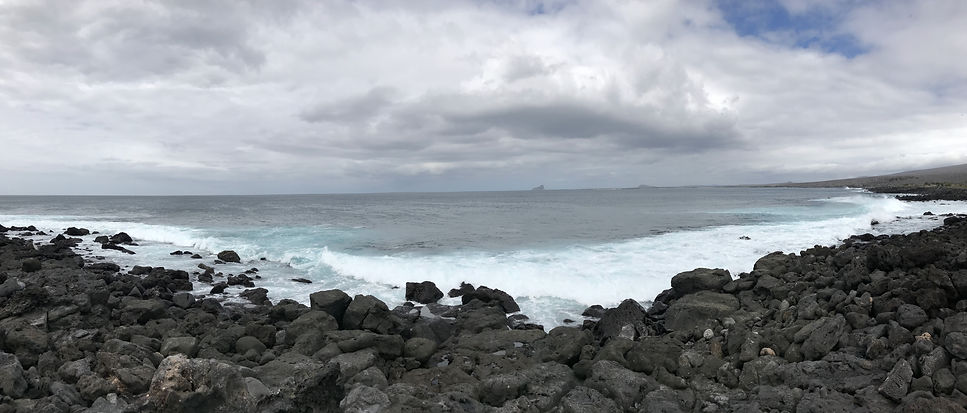
Most of the islands have a breeding center for Tortoise, which were almost on the verge of extinction! Apparently, pirates would come to the islands to steal tortoises, not with an intention of killing these docile animals but keeping them alive & slicing them bit by bit for fresh meat. Tortoises can live up to a 100 years without food & the pirates would turn them upside down so they couldn’t move! Around 100,000 tortoises disappeared in a similar manner. Such cruelty is simply unfathomable! Finally, Galapagos is exerting an effort towards setting up these breeding centers, where a few healthy tortoises were transported for 72 hours from their natural habitat after which they were placed in the center that reflects their natural habitat.
We spent maximum time here. Never having seen these fascinating creatures before, I was so intrigued by them & their interactions with each other. As they were eating, it was hilarious to see them reprimand each other if someone stepped into their space or took their food.
We did a pitstop at Playa Puerto Chino. The beaches are beautiful in Galápagos, one can find tons of spots amidst white sand, open skies & clear blue waters. And the highlight of every beach is of course having sea lions for company as you soak in the sun or snorkel & swim with them.
El Junco
It’s a 10 minute walk up to enjoy the view of the volcano’s crater. The day we headed towards El Junco, it started raining & the clouds were sitting tight on the laguna. As we spent a few minutes atop we caught a peekaboo of the laguna, but on a clear day it would be fun to walk around the crater & soak it all in.
2. Isla Lobos, Playa Ochoa
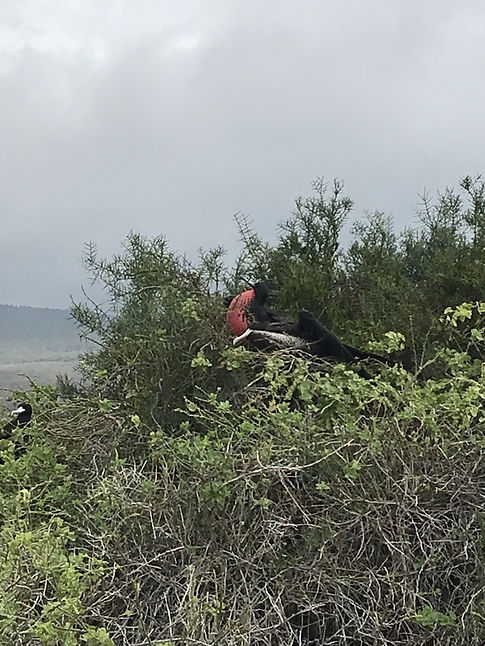
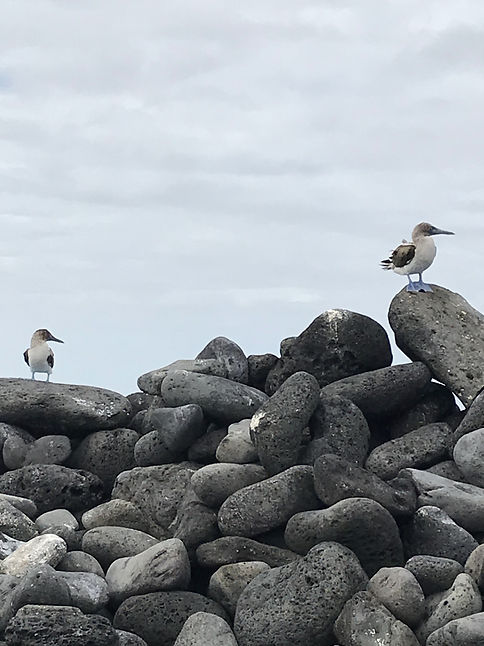

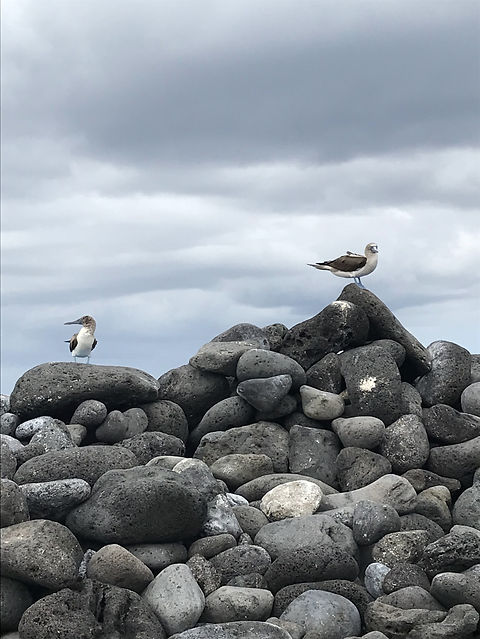
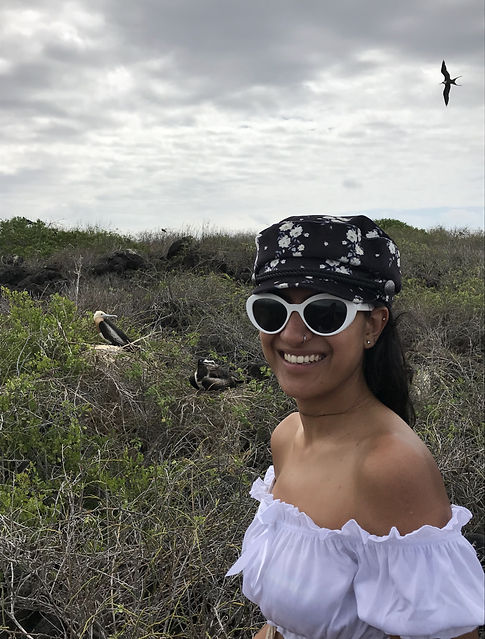
Isla Lobos is where birds such as the blue footed boobies and frigate birds nest, making a walk through the island perfect for birdwatching.
The Blue Footed Boobies have distinctive blue feet and the males proudly display their feet during the mating season, the bluer their feet apparently makes them a better prospective mate. Blue-footed boobies don’t mate for life & the moment their current mate looks away, they dance with another. Interestingly, they are not born with this color genetically but acquire it because of their diet. They love eating sardines and as a result, their feet & at time their beaks take on the same color.
3. Kicker Rock
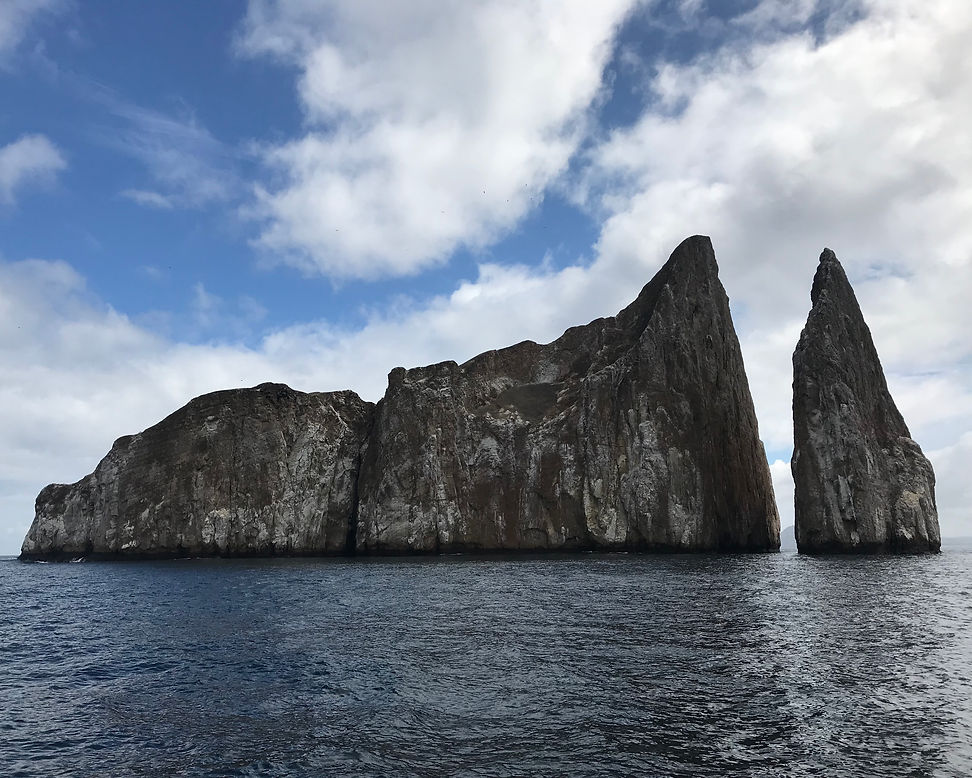
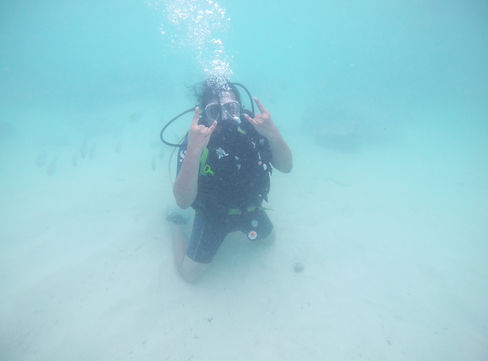

40 minutes away from San Cristóbal by boat, Kicker Rock is the hub of marine life. Looking at the Rock from a northern viewpoint, one sees the shape of a boot, thus the name, Kicker Rock. The formation extends deep under the water & as we snorkeled around the channels, we swam with sea turtles, hammerhead & Galapagos sharks, sea lions and sting rays. Experiencing a whole different universe with these incredible creatures was simply mesmerizing.
Generally, the tours select a different beach experience. Instead of the beach, we decided to do our very first scuba dive, which was a hell of an experience! A completely different feel from snorkeling, initially the act of getting used to breathing under water was tricky. It counteracts what the mind & body know to be the familiar way of inhaling & exhaling, and so the mind can create layers of anxiousness around one not being able to get out to the surface in time to breathe in as we normally do. The goal really is to relax into this different way of respiration, slowly but surely. A lot of it like everything else in life is a mind game, so building the confidence while focusing on each breath as one descends deeper & deeper leads to crossing over to the other side of tranquility, wonder & amazement, especially as one begins to notice the surrounding aquatic world. It helps to do it with friends, partners, familia as you support & inspire each other in this glorious shared experience!
Cuenca

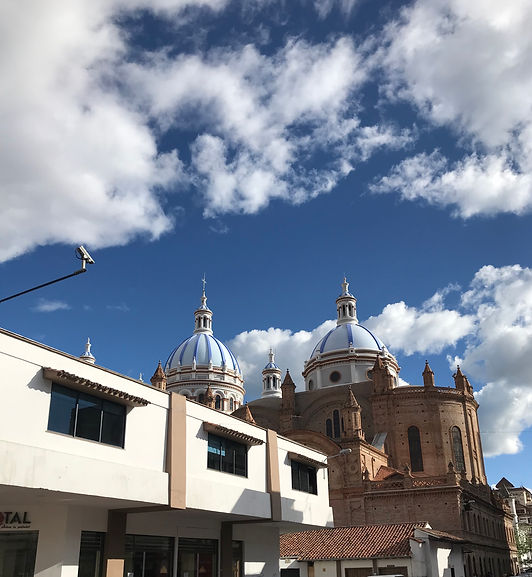
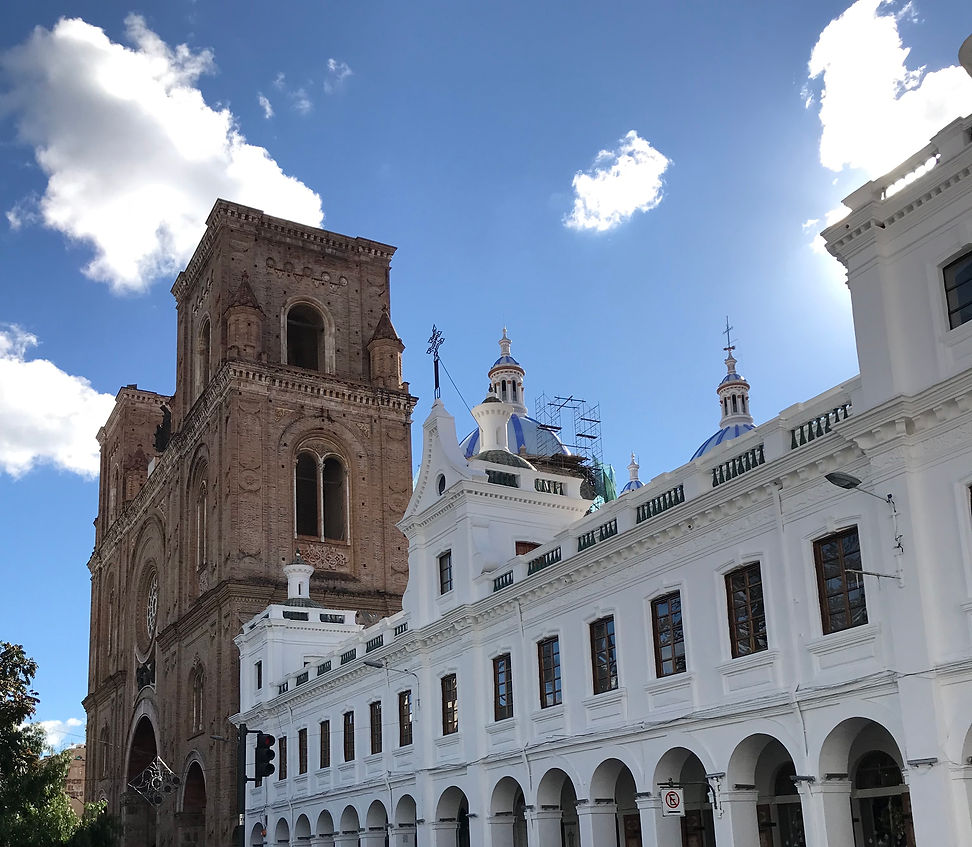
In the south of Ecuador, Cuenca is an old colonial town that is a must-visit. On the flight back from Galápagos, we disembarked in Guayaquil and took a 4-hour bus to Cuenca. Guayaquil is supremely well-connected and it was easy enough to jump on the next bus ($8 per person) with the bus terminal being in close proximity to the airport. There are options of taking a van, which accelerates the journey to 3 hours, but reading reviews online about not having the space to hold on & continually falling on each other resulting in white knuckles, led us to take the bus which was a comfortable ride.
History of Cuenca
The original inhabitants are traced back to the year 8060 BC, when folks were living as hunters and nomads through the Andean valley. Founded in 500 AD, Cuenca was a Cañari settlement known as Guapondeleg, which means land as big as heaven. The Incas from Peru made their way to Ecuador and conquered the Cañaris, replacing their architecture with their own but upholding achievements made by the Cañaris in agriculture and astronomy. The city has several museums such as Pumapungo, Culturas Aborigenes & Arte Moderno amongst others that are worth visiting.
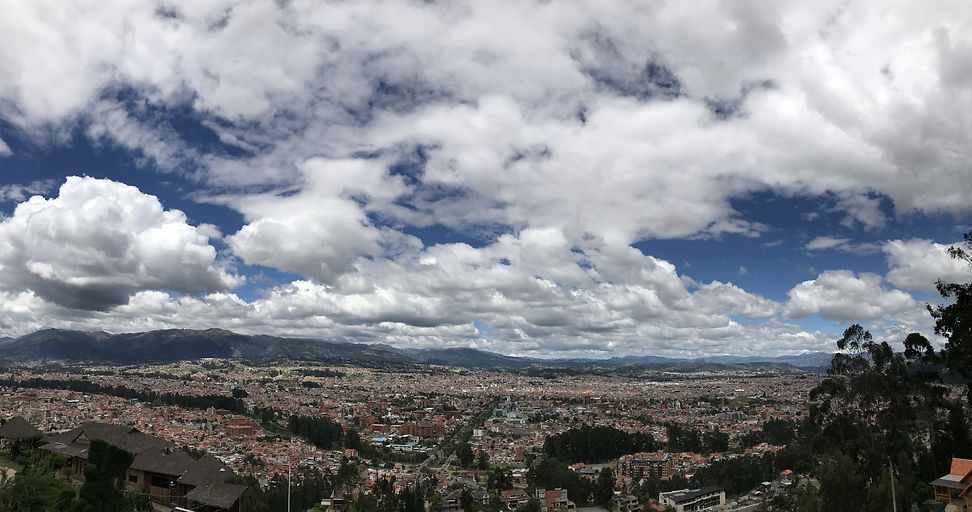
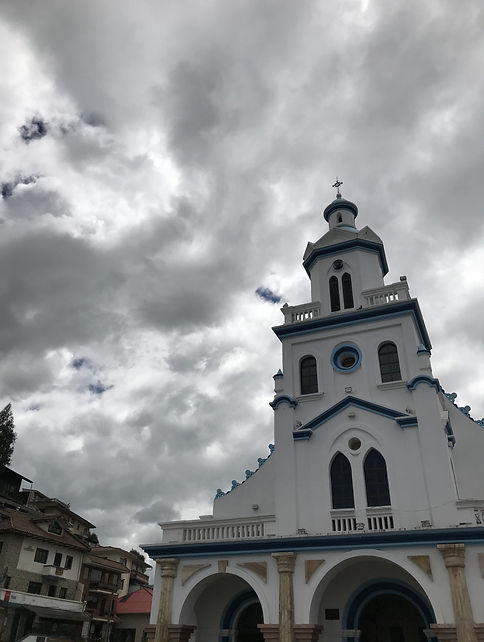

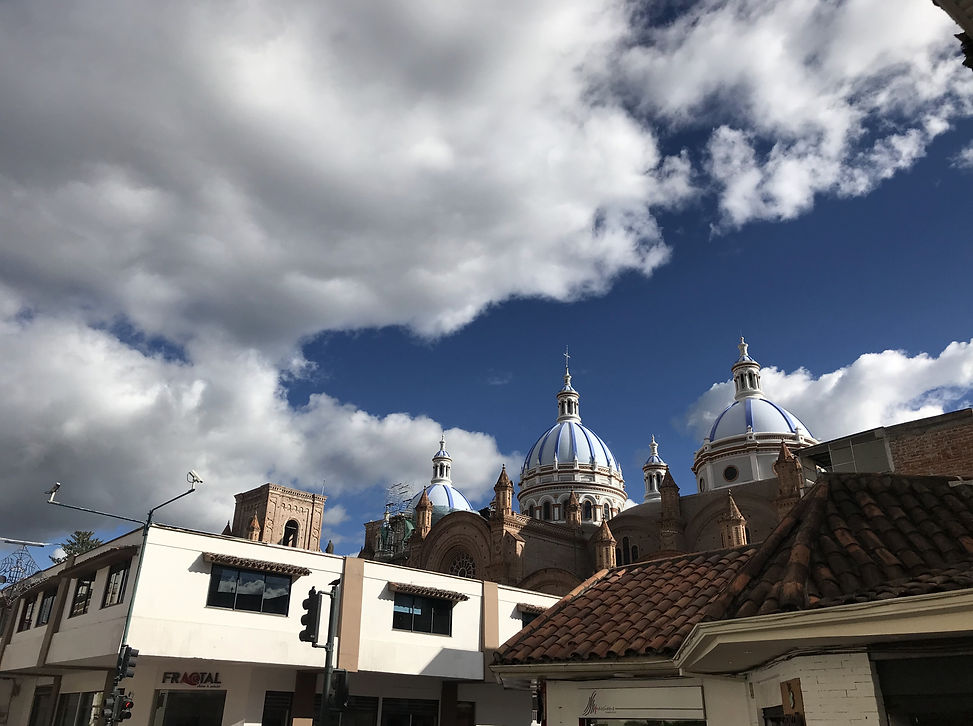
Cuenca has been declared a UNESCO world heritage site & the town unlike Quito remains contained in Centro Historico. Surrounded by hills, it has a similar feel of Medellín, but not as much of a city, the vibe reminded me more of Cusco & Arequipa in Peru. The center of town is characterized by the three blue domes aka the new Cathedral. Cuenca has 52 churches, one for every Sunday of the year. For $2, one can climb the 150 steps in the new cathedral to get a view of the city.
The best view of the city though is from a Mirador point, Ture. Barely 15 minutes away by cab ($5), it’s a great place to grab a meal as one enjoys the town of Cuenca. We ended up at Hell’s Grill, which was on the pricey side by Ecuadorian standards, but the view was worth it!
Calle Larga is the street, which has plethora of restaurants & my personal favorite was Goza Restaurant. With outside seating, it had everything you could be in the mood for, from cocktails to milkshakes, breakfast options, burgers and Ecuadorian cuisine.
Baños de Cuenca
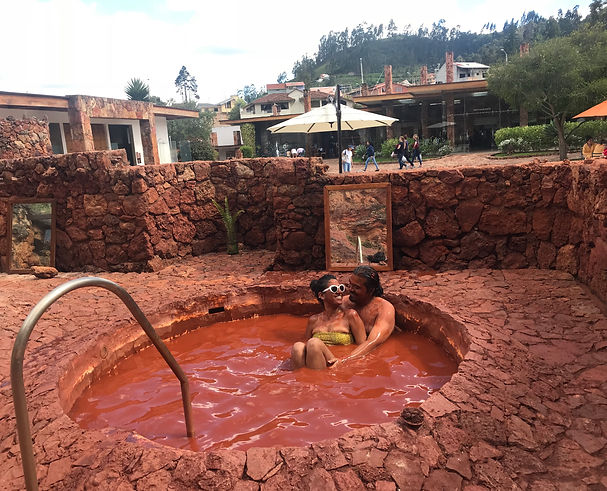
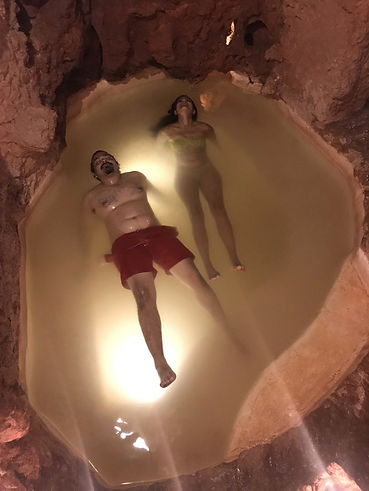

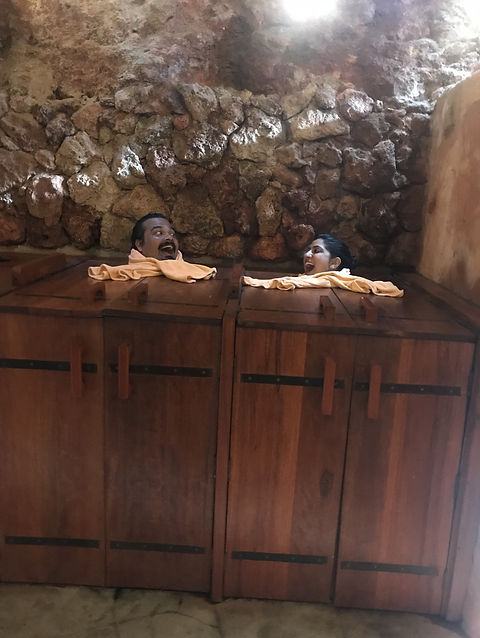
Known for the hot thermal springs, Baños de Cuenca is 15 minutes away by cab ($5) and the most perfect way to spend a relaxing day / afternoon. A 2 hour experience ($35, unless you make it for the early bird from 6:00 - 8:00 AM, with a deal for $15) involves a steam bath, bathing in red & blue volcanic mud, contrast pools & a steam box. After which one can spend the entire day in the hot thermal baths, while sipping on cocktails. There are three different baths with the Japanese one being the calmest, since the kiddos overtake the main one with their happy madness. My skin felt radiant & my body was so relaxed after the entire experience that I was knocked out as soon as I came in proximity with my bed :)
Baños

Instead of using Quito as a base to explore the towns of Baños & Alausi for the Devil’s Nose train, we decided to spend 4 days in Baños, which was a fantastic choice. A small town in the midst of the Andes, it’s filled with tiny cafes & stunning views, making for a perfect getaway spot. It has a very hill station feel to it. Baños is best known for adventure sports & one can zipline, canopy, sign up for jungle tours and much more. One can hire a bike for $5 / day.
Bus from Cuenca to Baños
There are three direct buses from Cuenca to Baños with a bus company called Amazonas. We only decided mid-morning that we would be spending the next few days in Baños, and since, we were traveling on the 31st Dec, buses were less frequent. Online reviews recommended Ambato as a connecting station, but the only bus we got was a bus to Riobamba (6 hours, $8 per person) so we jumped right on. We made it just in time to catch the last connecting bus to Baños (1.5 hours away) at 7:00 PM ($2 per person).
New Years Eve in Baños
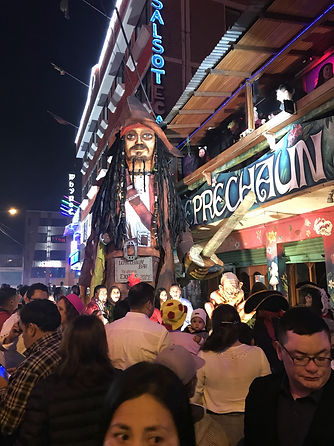


The initial plan was to spend NYE in Montañita, which every young Ecuadorian would tell you is an awesome way to celebrate, with coast towns being the epitome of sex, drugs & alcohol. However, we booked ourselves for an experience of Nariz del Diablo train (Devil’s Nose train) on the 2nd Jan & it would’ve been a hell of a task to travel from Montañita to the town of Alausi (8-10 hours) on the 1st of Jan to make it well in time. We didn’t want to spend 1st January in a bus, and so ended up moving around our entire itinerary, ending up in Baños on 31st night.
Baños, contrary to expectations, was a super place to celebrate NYE. The entire city is out on the streets, making it a version of Nola during Halloween. Ecuadorian tradition calls for the burning of paper maché effigies that are prepared in full enthusiasm before the night, to burn away evils of the passing year. Another tradition involves cross-dressing where men dress up as ‘widows’ with the culminating year being the dying husband. Something I’ve never witnessed before! People were dressed in wigs & costumes, it sure was a party! After the fireworks at 12, celebrations moved inside bars, Leprechaun bar is where we spent our night with multiple dance rooms & different music genres! Hola 2019!
Casa de Arbol


The famous swing of Baños is a super fun experience. With views of the Tungurahua volcano while swinging over the cliff gives an adrenaline rush! 10-12 kms away from Baños, taxis have a fixed rate of taking passengers for $10 one way or waiting for 40 minutes & bringing one back for $20. We negotiated the waiting time to an hour for the same price, to which our taxi driver agreed.
This spot is high up so it gets chilly, best to carry some warm clothing. The place can get crowded with locals & tourists alike with cues lining up for the swing, so best to time it at off-peak hours (avoiding the evenings). One can picnic here, for kiddos there are options of canopy / a baby version of river crossing, or just stroll around to enjoy the scenic landscapes.
Pailon del Diablo (waterfall)
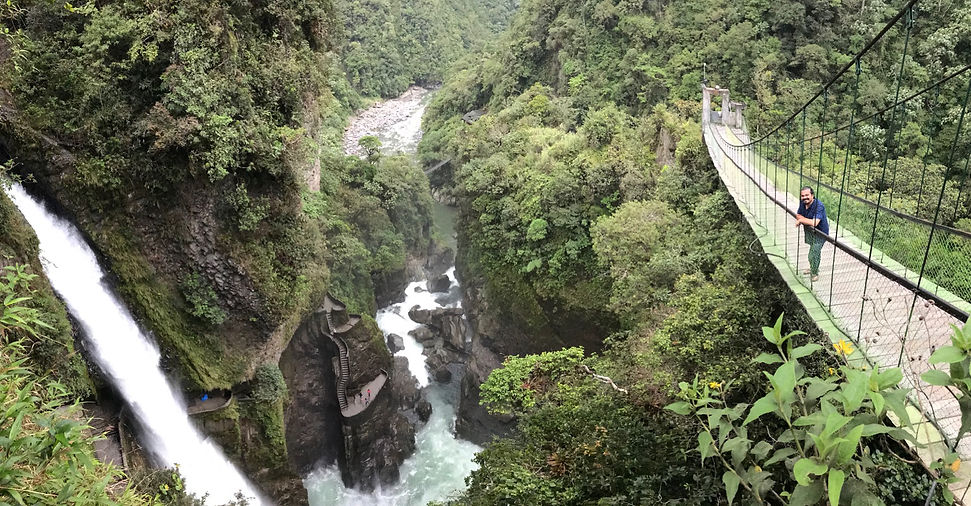
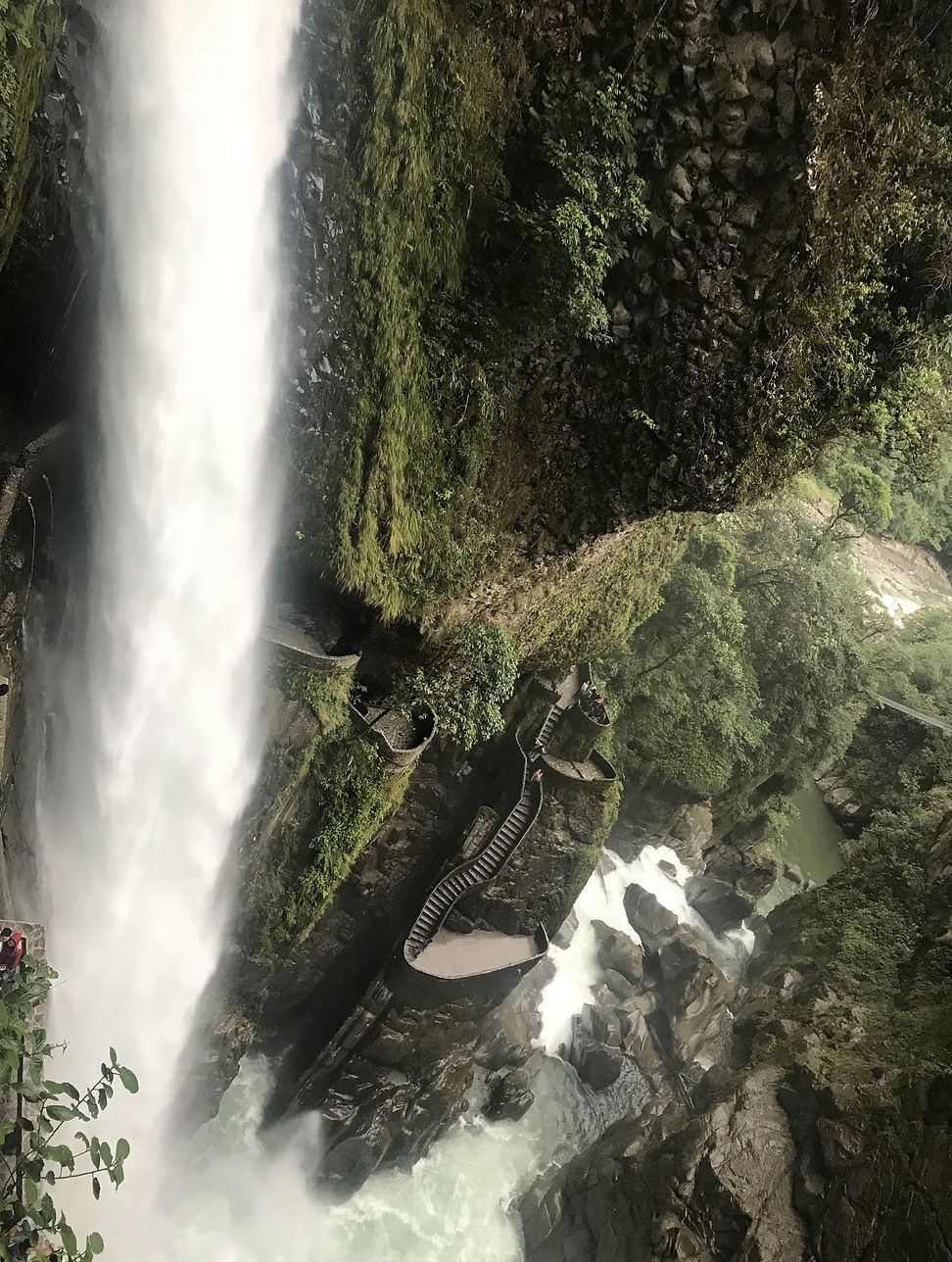


Similar to the deal of Casa De Arbol, taxis agreed to take us to the waterfall for $20, which included a return trip & the taxi waiting for us for around 1 / 1.15 hour. Buses are easily available as well and way cheaper.
Pailon Del Diablo is simply magnificent, words fail to capture what one feels the moment this cascada comes into sight for the very first time. As it comes in view, not only do you see the force of nature at her fiery & powerful best, but you realize the tiny specks we humans are in the face of nature, which is simply a force to be reckoned with.
Nariz del Diablo (Devil’s nose train)

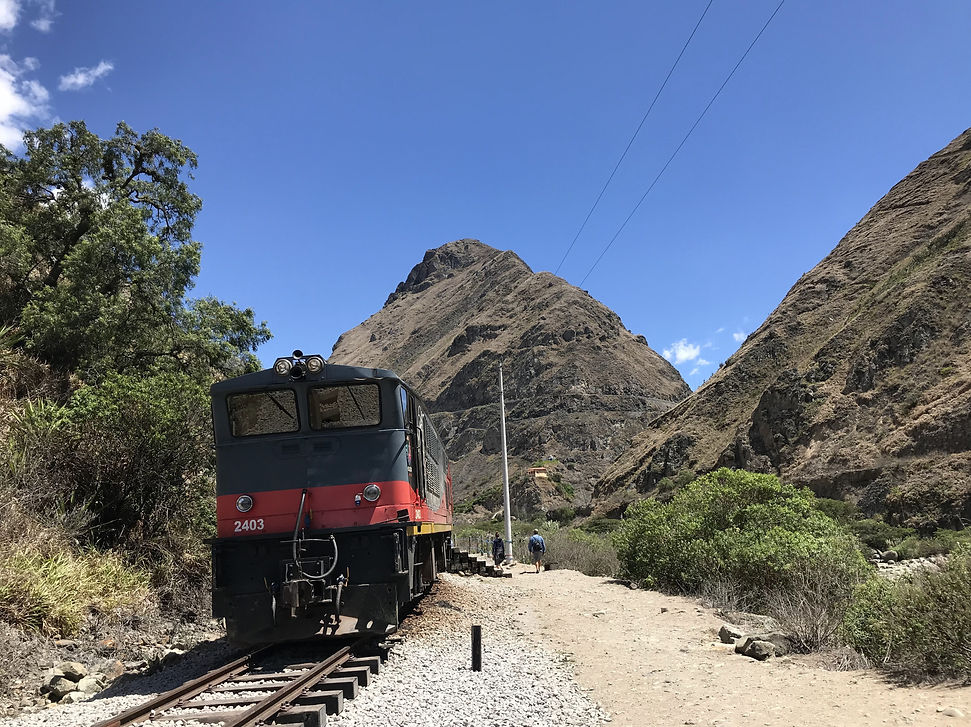
The train is in the town of Alausi, and from Baños we had to take a bus to Riobamba ($2 per person, 1.5 hours) & change buses for Alausi ($2.50 per person, 2 hours).
Ecuador has built a train experience, Nariz Del Diablo (Devil’s Nose) which commences from the town of Alausi & takes passengers to a town in the middle of nowhere, Sibambe, for a local cultural experience. Even though the train ride has been promoted as a scary ride over high cliffs, the ride itself is not hair-raising.
The history behind the construction of the train resulted in the name, since, people in thousands died while building these tracks (Jamaicans, Puerto Ricans & Haitians). In the initial years, there was a possibility of sitting on the train roof, which unfortunately resulted in the de-capitation of a few passengers, gulp! It’s a safe ride now, tickets have to be booked well in advance. The entire experience lasts 2 hours, as the train stops next to the steep stretch where most of the deaths took place, where now paradoxically tourists spend time taking several pictures. As the train enters the town of Sibambe, local indigenous people welcome the passengers with traditional songs & dances.
Personally, I wouldn’t recommend the train ride from afar, but if you find yourself in the town of Riobamba & have some time to kill, feel free to jump on the train wagon.

Crossing the border from Ecuador to Colombia
-
We took a bus at 1:00 AM from the Carcelen bus terminal and reached Tulcán at 5:00 AM. A taxi took us to the border for $3.
-
Immigration at Ecuador at 5:30 AM was easy peasy, literally took us 5 minutes to get stamped, after which we walked across the bridge to Rumichaca (no exit fee).
-
Immigration at Colombia took much longer around 2 hours!! Apparently we weren’t only the ones who thought of the bright idea of crossing early morning. Lines were long, their staff was slow & Non-Colombians aka foreigners were being made to wait more (no entrance fee).
-
Eventually, we made our way through & a taxi cost us 5000 pesos to the Ipiales bus terminal
-
Our next stop was Pasto, and almost immediately we were able to jump on to a shuttle bus, which depart every 10 minutes ($10,000 pesos per person).

